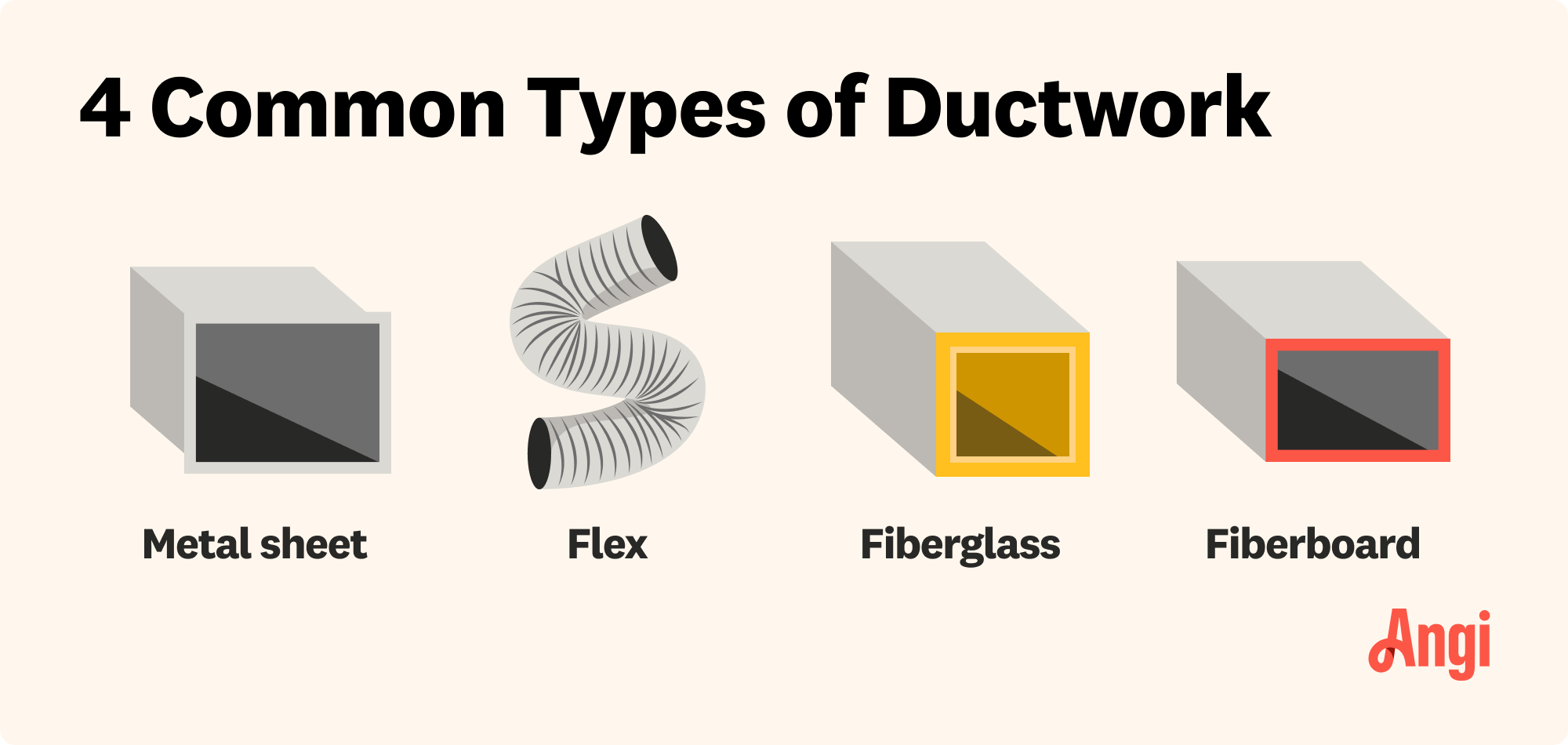
If you’re having problems with your air conditioner’s condenser, it may be time for an upgrade. Learn about the cost to replace an AC condenser in this guide.
Channel your home’s energy with the right kind


Ductwork is the hidden backbone of your home’s HVAC system. While you may not be familiar with all the HVAC duct types that are out there, it helps to know which variety is in your home or which type works best should you need a repair or complete replacement.
| Type of Ductwork | Lifespan in Years |
|---|---|
| Flexible | 10–15 |
| Sheet metal | 30–50 |
| Fiberboard | 10–20 |
| Fiberglass lined | 15–25 |
Quality ductwork will increase the efficiency of your HVAC, sometimes by 20% to 30%. This is because there is reduced air leakage due to better insulation and more optimized airflow. This means your HVAC doesn't have to work as hard to keep the desired temperature, so it uses less energy.
Flexible ductwork consists of a metal wire coil covered by a layer of plastic. Its thermal insulation is made of glass wool, which helps reduce heat loss or gain and improves energy efficiency. This type of ductwork is commonly used in smaller, single-story homes with tight spaces.
| Pros | Cons |
|---|---|
| Budget-friendly | Damages easily |
| Easy to install | Prone to sagging |
| Good for small spaces | Can restrict airflow over time |
Best for: Smaller homes with tighter budgets
As its name suggests, sheet metal ductwork is made of galvanized steel, aluminum, or stainless steel. This type of ductwork can be shaped into round, spiral, or rectangular ducts and is one of the most durable types available. It falls on the higher end of the price range due to its ability to resist mold and pests.
| Pros | Cons |
|---|---|
| Durable | More expensive |
| Resistant to mold and pets | Requires professional installation |
| Promotes good airflow | Prone to air leaks |
Best for: Larger homes in humid or extreme climates
This ductwork type consists of compressed resin-bonded fiberglass topped with a foil laminate to prevent moisture buildup and leakage. Because of its rough material, it can be prone to trapping dust and debris, so it helps to consider the cost of air duct cleaning if you’re thinking about installing fiberboard ductwork.
| Pros | Cons |
|---|---|
| Built-in insulation | Shorter lifespan |
| Budget-friendly | Can trap dust and debris |
| Reduces noise | Less airflow efficiency |
Best for: Small homes in moderate climates
Fiberglass-lined ductwork is made of sheet metal ducts coated with a layer of fiberglass insulation. It’s beneficial for open spaces that need noise control and more consistent thermal control.
The main downside is that it’s possible for fiberglass-lined ducts to deteriorate and release small particles of fiberglass into the air, which can be harmful for people who struggle with breathing conditions like asthma.
| Pros | Cons |
|---|---|
| Improved insulation | Can affect indoor air quality |
| Quiet | Shorter lifespan |
| Controls condensation | Difficult to clean |
Best for: Commercial buildings or offices

Don’t try to climb up into an attic to learn more about duct systems. A local ductwork installer can take a look at your home or plans for your home to make recommendations on the right type of ductwork for you. HVAC ductwork can make the difference between a well-heated home or one that harbors mold and has you shivering in below-freezing temperatures.
Came and replaced water filter and UV light. Very nice man.
Very satisfied with the work and prices reasonable. Professional respectful and cean. Will recommended to anyone.
They were great! Flexible on timeframe and got everything we discussed done quickly and without issue. Thank you Noel!!
The visit was great. The electrician was friendly and and easy to work with.
Installation was efficient and timely. Crew was knowledgeable and friendly. Discovered a leak in a couple of corner seams, awaiting fix from contractor. One downspout splash block was broken and needs replaced. Waiting for that also. A callback visit is necessary.
Hamilton and his team was excellent. I have a few more things I need done and I will definitely be calling him.
I had a great experience. The owner was very uplifting and pleasant when he called. He understood the system that I was trying to explain I wanted for my garage. I wanted a mini split system with hot and cool air for my garage. He sent a sales/survey person Andy who surveyed my area and...
Service was fast, efficient and professional. Kevin Johnson and Josh Wise weâ re the best!
Good job power washing our home and cleaning the windows. Both crews were professional, and explained what they were doing to the windows and the siding before they started. The window cleaning crew wore protective shoe coverings. I wish I would have known to order the premium window...
Cleaning and vacuumed the gas log fireplace. Checked the chimney mortar and lining. Efficient and friendly service.
From average costs to expert advice, get all the answers you need to get your job done.

If you’re having problems with your air conditioner’s condenser, it may be time for an upgrade. Learn about the cost to replace an AC condenser in this guide.

Switching from oil to gas heating could impact your savings. This guide will help you understand the cost to convert from an oil furnace to a gas furnace.

Discover how much R-22 refrigerant costs per pound based on factors such as the size, age, and location of your HVAC unit.

Tackling unwanted odors from indoor plants can be tricky. Learn how to use a carbon filter in your duct fan to improve air quality.

Your return air vent is responsible for removing warmer air, so testing it ensures you keep your environment comfortable and there are no HVAC problems.

Figuring out how to eliminate ductwork noise may require anything from replacing the ducts to changing the filter. Learn more about fixing this issue.